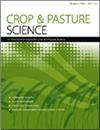Agronomic responses and herbage nutritive value of elephant grass (Cenchrus purpureus) genotypes grown as monocrops and mixed with butterfly pea (Clitoria ternatea)
IF 1.9
4区 农林科学
Q2 AGRICULTURE, MULTIDISCIPLINARY
引用次数: 1
Abstract
ABSTRACT Context. Introducing legumes into grass-based forage systems may increase herbage nutritive value while reducing the need for inorganic nitrogen fertilisation. Grass–legume intercrops may also enhance herbage yield stability. Aim. We evaluated agronomic and nutritional traits of elephant grass (Cenchrus purpureus Schum.) genotypes grown as monocrops and mixed with butterfly pea (Clitoria ternatea L.). Methods. Elephant grass genotypes, two tall (Elephant B and IRI-381) and two dwarf (Mott and Taiwan A-146 2.37), were grown as monocultures or intercropped with butterfly pea in a 2-year trial. Herbage accumulation, yield stability, botanical composition and chemical/bromatological variables were evaluated. Key results. Herbage accumulation was highest (P < 0.001) in Elephant B under monocropping (21.9 t/ha.year); however, this treatment revealed the lowest yield stability over harvest times (σi2 5.59). All intercrops were more stable than grass monocrops (mean σi2 0.66 vs 2.55). Higher (P < 0.001) concentrations of herbage crude protein were found in intercrops than monocrops (mean 113 vs 90 g/kg). Intercrop herbage lignin contents (mean 57 g/kg) and protein fraction C (mean 61 g/kg) were higher than those in monocrops. Dwarf Mott had higher (P = 0.001) digestible dry matter concentration than dwarf Taiwan (755 vs 745 g/kg). Conclusions. Dwarf Mott genotype has outstanding nutritive value because of its higher leaf:stem ratio. Butterfly pea legume added to elephant grass crop in cut-and-carry systems improves herbage yield stability by reducing seasonal effects. Implications. Intercropping butterfly pea in grass-based systems enhances yield stability, allowing herbage harvest with good nutritive value.象草单作与蝶豆混作基因型的农艺反应及牧草营养价值
本文章由计算机程序翻译,如有差异,请以英文原文为准。
求助全文
约1分钟内获得全文
求助全文
来源期刊

Crop & Pasture Science
AGRICULTURE, MULTIDISCIPLINARY-
CiteScore
4.20
自引率
15.80%
发文量
111
审稿时长
3 months
期刊介绍:
Crop and Pasture Science (formerly known as Australian Journal of Agricultural Research) is an international journal publishing outcomes of strategic research in crop and pasture sciences and the sustainability of farming systems. The primary focus is broad-scale cereals, grain legumes, oilseeds and pastures. Articles are encouraged that advance understanding in plant-based agricultural systems through the use of well-defined and original aims designed to test a hypothesis, innovative and rigorous experimental design, and strong interpretation. The journal embraces experimental approaches from molecular level to whole systems, and the research must present novel findings and progress the science of agriculture.
Crop and Pasture Science is read by agricultural scientists and plant biologists, industry, administrators, policy-makers, and others with an interest in the challenges and opportunities facing world agricultural production.
Crop and Pasture Science is published with the endorsement of the Commonwealth Scientific and Industrial Research Organisation (CSIRO) and the Australian Academy of Science.
 求助内容:
求助内容: 应助结果提醒方式:
应助结果提醒方式:


